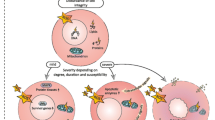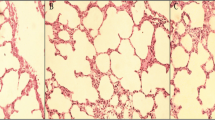Abstract
Severe acute pancreatitis is characterized by pancreatic necrosis, resulting in local and systemic inflammation. Hyperbaric oxygen (HBO) therapy modulates inflammation, but has not been extensively studied in pancreatitis. This study investigates the effects of HBO in a rat model of severe acute pancreatitis. Sixty-four rats were induced with severe pancreatitis using 4% sodium taurocholate and randomized to HBO treatment or control. HBO was commenced 6 h after induction (100% oxygen at 2.5 atmospheres for 90 min) and continued every 12 h for a maximum of eight treatment episodes. Surviving animals were killed at 7 days. Severity of pancreatitis was graded macroscopically and microscopically. Lung edema was calculated using wet and dry lung weights. Macroscopic and microscopic severity scores (mean ± SE) of HBO-treated animals with pancreatitis (8.3 ± 0.7; 9.6 ± 0.4) were lower than those of controls (10.5 ± 0.5; 11.1 ± 0.4) (p = 0.02 and p = 0.03, respectively). The HBO-treated group had reduced pancreatic necrosis compared to controls (40 ± 4% vs. 54 ± 4%; p = 0.003). There was no difference in pulmonary edema between the groups. Median survival in the HBO-treatment group was 51 h, compared to 26 h in controls. Day-7 survival was significantly improved in the HBO-treated animals compared to controls (40% vs. 27%; p = 0.04). HBO therapy reduces overall severity, decreases the extent of necrosis, and improves survival in severe acute pancreatitis.



Similar content being viewed by others
References
Toouli J, Brooke-Smith M, Bassi C, Carr-Locke D, Telford J, Freeny P, Imrie C, Tandon R, Working Party of the Program Committee of the Bangkok World Congress of G. Guidelines for the management of acute pancreatitis. J Gastroenterol Hepatol 2002;17(Suppl):S15–S39.
Steinberg W, Tenner S. Medical progress: acute pancreatitis. N Engl J Med 1994;330:1198–1210.
Bradley EL, 3rd. A clinically based classification system for acute pancreatitis. Summary of the International Symposium on Acute Pancreatitis, Atlanta, GA, September 11 through 13, 1992 [see comment]. Arch Surg 1993;128:586–590.
Beger HG, Rau B, Isenmann R. Natural history of necrotizing pancreatitis. Pancreatology 2003;3:93–101.
Furukawa M, Kimura T, Sumii T, Yamaguchi H, Nawata H. Role of local pancreatic blood flow in development of hemorrhagic pancreatitis induced by stress in rats. Pancreas 1993;8:499–505.
Johansson M, Carlsson PO, Jansson L. Caerulein-induced pancreatitis and islet blood flow in anesthetized rats. J Surg Res 2003;113:13–20.
Kerner T, Vollmar B, Menger MD, Waldner H, Messmer K. Determinants of pancreatic microcirculation in acute pancreatitis in rats. J Surg Res 1996;62:165–171.
Kinnala PJ, Kuttila KT, Gronroos JM, Havia TV, Nevalainen TJ, Niinikoski JH. Pancreatic tissue perfusion in experimental acute pancreatitis. Eur J Surg 2001;167:689–694.
Chen HM, Sunamura M, Shibuya K, Yamauchi JI, Sakai Y, Fukuyama S, Mikami Y, Takeda K, Matsuno S. Early microcirculatory derangement in mild and severe pancreatitis models in mice. Surg Today 2001;31:634–642.
Foitzik T, Eibl G, Hotz B, Hotz H, Kahrau S, Kasten C, Schneider P, Buhr HJ. Persistent multiple organ microcirculatory disorders in severe acute pancreatitis: experimental findings and clinical implications. Dig Dis Sci 2002;47:130–138.
Menger MD, Plusczyk T, Vollmar B. Microcirculatory derangements in acute pancreatitis. J Hepatobiliary Pancreat Surg 2001;8:187–194.
Sunamura M, Yamauchi J, Shibuya K, Chen HM, Ding L, Takeda K, Kobari M, Matsuno S. Pancreatic microcirculation in acute pancreatitis. J Hepatobiliary Pancreat Surg 1998;5:62–68.
Mitchell RM, Byrne MF, Baillie J. Pancreatitis. Lancet 2003;361:1447–1455.
Gill AL, Bell CN. Hyperbaric oxygen: its uses, mechanisms of action and outcomes. QJM 2004;97:385–395.
Allen DB, Maguire JJ, Mahdavian M, Wicke C, Marcocci L, Scheuenstuhl H, Chang M, Le AX, Hopf HW, Hunt TK. Wound hypoxia and acidosis limit neutrophil bacterial killing mechanisms. Arch Surg 1997;132:991–996.
Brown OR. Reversible inhibition of respiration of Escherichia coli by hyperoxia. Microbios 1972;5:7–16.
Schmidt J, Rattner DW, Lewandrowski K, Compton CC, Mandavilli U, Knoefel WT, Warshaw AL. A better model of acute pancreatitis for evaluating therapy. Ann Surg 1992;215:44–56.
Laboratory Animal Science Association Working Party. The assessment and control of the severity of scientific procedures on laboratory animals. Lab Anim 1990;24:97–130.
Schulz HU, Hoenl H, Schrader T, Kropf S, Halangk W, Ochmann C, Matthias R, Letko G, Roessner A, Lippert H, Niederau C. Randomized, placebo-controlled trial of lazaroid effects on severe acute pancreatitis in rats. Crit Care Med 2001;29:861–869.
Yotsumoto F, Manabe T, Kyogoku T, Hirano T, Ohshio G, Yamamoto M, Imamura T, Yoshitomi S. Platelet-activating factor involvement in the aggravation of acute pancreatitis in rabbits. Digestion 1994;55:260–267.
Yotsumoto F, Manabe T, Ohshio G. Bradykinin involvement in the aggravation of acute pancreatitis in rabbits. Digestion 1993;54:224–230.
Maxson CJ, Greenfield SM, Turner JL. Acute pancreatitis as a common complication of 2′,3′-dideoxyinosine therapy in the acquired immunodeficiency syndrome. Am J Gastroenterol 1992;87:708–713.
Swaroop VS, Chari ST, Clain JE. Severe acute pancreatitis. JAMA 2004;291:2865–2868.
Buchler MW, Gloor B, Muller CA, Friess H, Seiler CA, Uhl W. Acute necrotizing pancreatitis: treatment strategy according to the status of infection. Ann Surg 2000;232:619–626.
Chardavoyne R, Asher A, Bank S, Stein TA, Wise L. Role of reactive oxygen metabolites in early cardiopulmonary changes of acute hemorrhagic pancreatitis. Dig Dis Sci 1989;34:1581–1584.
Murakami H, Nakao A, Kishimoto W, Nakano M, Takagi H. Detection of O2-generation and neutrophil accumulation in rat lungs after acute necrotizing pancreatitis. Surgery 1995;118:547–554.
Weidenbach H, Lerch MM, Gress TM, Pfaff D, Turi S, Adler G. Vasoactive mediators and the progression from oedematous to necrotising experimental acute pancreatitis. Gut 1995;37:434–440.
Jungermann J, Lerch MM, Weidenbach H, Lutz MP, Kruger B, Adler G. Disassembly of rat pancreatic acinar cell cytoskeleton during supramaximal secretagogue stimulation. Am J Physiol 1995;268:G328–G338.
Norman J. The role of cytokines in the pathogenesis of acute pancreatitis. Am J Surg 1998;175:76–83.
Hughes CB, Gaber LW, Mohey el-Din AB, Grewal HP, Kotb M, Mann L, Gaber AO. Inhibition of TNF alpha improves survival in an experimental model of acute pancreatitis. Am Surg 1996;62:8–13.
Tanaka N, Murata A, Uda K, Toda H, Kato T, Hayashida H, Matsuura N, Mori T. Interleukin-1 receptor antagonist modifies the changes in vital organs induced by acute necrotizing pancreatitis in a rat experimental model. Crit Care Med 1995;23:901–908.
Oruc N, Ozutemiz AO, Yukselen V, Nart D, Celik HA, Yuce G, Batur Y. Infliximab: a new therapeutic agent in acute pancreatitis? Pancreas 2004;28:e1–e8.
Schoenberg MH, Buchler MW, Younes M, Kirchmayr R, Bruckner UB, Beger HG. Effect of antioxidant treatment in rats with acute hemorrhagic pancreatitis. Dig Dis Sci 1994;39:1034–1040.
Norman JG, Franz MG, Fink GS, Messina J, Fabri PJ, Gower WR, Carey LC. Decreased mortality of severe acute pancreatitis after proximal cytokine blockade. Ann Surg 1995;221:625–631; discussion 631–624.
Marx RE, Ehler WJ, Tayapongsak P, Pierce LW. Relationship of oxygen dose to angiogenesis induction in irradiated tissue. Am J Surg 1990;160:519–524.
Bean J. Effects of oxygen at increased pressure. Physiol Rev 1945;25:1.
Tibbles PM, Edelsberg JS. Hyperbaric-oxygen therapy. N Engl J Med 1996;334:1642–1648.
Grim PS, Gottlieb LJ, Boddie A, Batson E. Hyperbaric oxygen therapy. JAMA 1990;263:2216–2220.
Dubois L, Landuyt W, Haustermans K, Dupont P, Bormans G, Vermaelen P, Flamen P, Verbeken E, Mortelmans L. Evaluation of hypoxia in an experimental rat tumour model by [(18)F]fluoromisonidazole PET and immunohistochemistry. Br J Cancer 2004;91:1947–1954.
Benson RM, Minter LM, Osborne BA, Granowitz EV. Hyperbaric oxygen inhibits stimulus-induced proinflammatory cytokine synthesis by human blood-derived monocyte-macrophages. Clin Exp Immunol 2003;134:57–62.
Buras JA, Stahl GL, Svoboda KK, Reenstra WR. Hyperbaric oxygen downregulates ICAM-1 expression induced by hypoxia and hypoglycemia: the role of NOS. Am J Physiol Cell Physiol 2000;278:C292–C302.
Luongo C, Imperatore F, Cuzzocrea S, Filippelli A, Scafuro MA, Mangoni G, Portolano F, Rossi F. Effects of hyperbaric oxygen exposure on a zymosan-induced shock model [see comment]. Crit Care Med 1998;26:1972–1976.
Gadd MA, McClellan DS, Neuman TS, Hansbrough JF. Effect of hyperbaric oxygen on murine neutrophil and T-lymphocyte functions. Crit Care Med 1990;18:974–979.
Kalns J, Lane J, Delgado A, Scruggs J, Ayala E, Gutierrez E, Warren D, Niemeyer D, George Wolf E, Bowden RA. Hyperbaric oxygen exposure temporarily reduces Mac-1 mediated functions of human neutrophils. Immunol Lett 2002;83:125–131.
Izawa K, Tsunoda T, Ura K, Yamaguchi T, Ito T, Kanematsu T, Tsuchiya R. Hyperbaric oxygen therapy in the treatment of refractory peripancreatic abscess associated with severe acute pancreatitis. Gastroenterol Jpn 1993;28:284–291.
Chen HM, Shyr MH, Ueng SW, Chen MF. Hyperbaric oxygen therapy attenuates pancreatic microcirculatory derangement and lung edema in an acute experimental pancreatitis model in rats. Pancreas 1998;17:44–49.
Isik AT, Mas MR, Comert B, Yasar M, Korkmaz A, Akay C, Deveci S, Tasci I, Mas N, Ates Y, Kocar IH. The effect of combination therapy of hyperbaric oxygen, meropenem, and selective nitric oxide synthase inhibitor in experimental acute pancreatitis. Pancreas 2004;28:53–57.
Yasar M, Yildiz S, Mas R, Dundar K, Yildirim A, Korkmaz A, Akay C, Kaymakcioglu N, Ozisik T, Sen D. The effect of hyperbaric oxygen treatment on oxidative stress in experimental acute necrotizing pancreatitis. Physiol Res 2003;52:111–116.
Zalaudek G, Hofler H, Pinter H, Santner V, Giebler A, Berger A, Stolze A, Rehak P. Hyperbaric oxygen therapy in experimental necrotising pancreatitis (author’s translation). Dtsch Z Verdau Stoffwechselkr 1982;42:7–13.
Buchler M, Friess H, Uhl W, Beger HG. Clinical relevance of experimental acute pancreatitis. Eur Surg Res 1992;24(Suppl 1):85–88.
Weaver LK, Churchill S. Pulmonary edema associated with hyperbaric oxygen therapy. Chest 2001;120:1407–1409.
Pott F, Westergaard P, Mortensen J, Jansen EC. Hyperbaric oxygen treatment and pulmonary function. Undersea Hyperb Med 1999;26:225–228.
Author information
Authors and Affiliations
Corresponding author
Rights and permissions
About this article
Cite this article
Nikfarjam, M., Cuthbertson, C.M., Malcontenti-Wilson, C. et al. Hyperbaric Oxygen Therapy Reduces Severity and Improves Survival in Severe Acute Pancreatitis. J Gastrointest Surg 11, 1008–1015 (2007). https://doi.org/10.1007/s11605-007-0175-2
Published:
Issue Date:
DOI: https://doi.org/10.1007/s11605-007-0175-2




